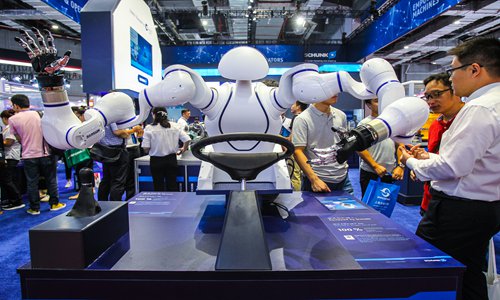HOME >> BUSINESS
President Xi stresses industrial self-reliance
By Chu Daye and Yang Kunyi Source:Global Times Published: 2019/9/18 21:43:40
Manufacturing sector seeks upgrades to develop advanced products

Visitors look at a service robot at the 21st China International Industry Fair in Shanghai on Tuesday. Photo: VCG
Domestic manufacturing dominated the stage of a key industrial exposition in Shanghai on Wednesday, a show of China's continuous efforts to upgrade its manufacturing sector in pursuit of high-technology, advanced products.The upgrading process got a fresh boost from China's top leader as Chinese President Xi Jinping emphasized the need to prioritize manufacturing during an inspection trip to Central China's Henan Province on Tuesday.
Industrial robots, computers that control Beijing's driverless subway trains, carrier rockets and passenger planes with proprietary intellectual property galvanized the "Made in China" theme at the ongoing China International Industry Fair in Shanghai, domestic news site xinmin.cn reported on Wednesday.
Xi urged the development of the real economy bolstered by manufacturing, with self-reliance as the basis of all endeavors, during his tour to Henan on Tuesday. Xi also pointed out that although China has the largest manufacturing sector in the world, efforts are still needed in realizing industrial transformation and upgrading through innovation.
Highlights in the manufacturing industry in the past decade include the development of nuclear energy, chipset production, automobiles and aviation industry, Tian Yun, a vice director of the Beijing Economic Operation Association, told the Global Times on Wednesday.
"The past decade has witnessed the rise of many strong domestic companies. Companies such as Huawei and Geely are taking rapidly increasing shares in the global market," Tian said. "The considerable domestic market also provides strong support for the growth of domestic manufacturers."
However, Tian noted that the upgrading of China's manufacturing sector still requires the market to take a more dominant role in research and development and technological innovation.
"Most frontline research is done by institutions and universities," Tian said. "Compared with the US, our manufacturing industry is much less market-oriented. To upgrade the manufacturing sector, the industry must be able to transform innovations into market-ready products more efficiently."
Investment in manufacturing increased 2.6 percent from January to August this year, 0.7 percentage points less than in the first seven months, according to Guotai Junan Securities.
Strong manufacturing contributed handsomely to the world's second-largest economy.
The country's lead in rolling stock and high-speed railways has resulted in the world's largest high-speed railway system.
A subsidiary of the world's largest train producer CRRC unveiled on Tuesday a perpetual magnet motor powered by rare-earth elements.
The motor could harness power more efficiently than the current models and is set to be used on cross-country high-speed bullet trains that run at 400 kilometers per hour. The new motor will be instrumental in one of China's key transportation projects - the 400 km/h inter-country connectivity bullet train.
In the telecommunication field, strong manufacturing ensured the country's lead in mobile internet and the roll-out of the 5G wireless network.
During the past decade, Chinese manufacturing made breakthroughs in satellite navigation systems and rolling stock. The convergence of information technology and advanced manufacturing, and the emergence of manufacturing clusters, became prevailing trends, analysts said.
Chinese manufacturing kept growing in quality, with the top 500 companies in the advanced manufacturing category gaining combined annual revenue of nearly 8 trillion yuan and an average profit margin of 16.9 percent, reports said on Wednesday, citing a recent report by CCID Consulting.
These companies posted a compound annual revenue growth rate of 39 percent over the past three years, the report found. The Yangtze River Delta had the highest concentration of top 500 companies.
According to a National Business Daily report on Wednesday, 41 funds focusing on the manufacturing sector reaped an average year-to-date gain of 30.93 percent.
Posted in: ECONOMY